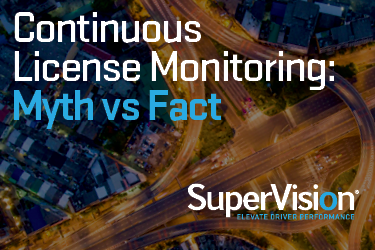
Just one liability lawsuit can bankrupt a company
By Trent Dressen, Director of Sales, SuperVision
We get it, businesses are always trying to save money while increasing profit. At first glance, continuous license monitoring may appear to be an additional unnecessary expense, but this proactive approach yields substantial cost savings for fleet management in the long run.
Myth: Continuous License Monitoring is Too Expensive
Fact: Save money with risky driver alerts.
Across the industry, it is reported that 20% of each fleet is involved in a crash annually. Just one “bent metal” crash cost employers $5,800 on average. For a fleet of 1,000 drivers, that’s 200 crashes and $1.16 million in employer cost per year, if there are no injuries or fatalities. When crashes become more severe causing injuries or fatalities, the costs to employers will grow exponentially. Forty years of continuous license monitoring for a 1,000-driver fleet, on average, costs less for a company than just one fatal accident.
Removing (or minimizing the effects of) risky drivers from the road is the highest value a fleet can gain from its safety program; not only because it protects lives but goes directly to protecting a company’s bottom line.
Fact: Just one liability lawsuit can bankrupt a company
Annual MVR pulls provide a grace period to risky drivers for up to a year to remain on the road. Risky drivers are more likely to cause accidents; some accidents are serious enough to warrant a wrongful death case against the driver or negligent entrustment case against the fleet company.
A 2019 verdict award from a commercial driving wreck lawsuit was the highest in history against a fleet company at $280 million. The average verdict award (not including settlements) has climbed to $17.5 million.
Fact: Time is Money
Annual MVR checks with batch processing of driver MVR reports is more time consuming than continuous driver license monitoring. Annual MVR checks use valuable resources by manually going through all MVRs, for all drivers, each year. If each MVR review took roughly 5 minutes per driver it could amount to an exorbitant number of staff hours.
For example, for a fleet consisting of 1,000 drivers and using the 5-minute review average, that’s 83 hours or over two full workweeks of labor costs to review MVRs.
Continuous license monitoring can satisfy annual MVR check requirements; eliminating the costs associated with pulling and reviewing the MVRs of the 80% of drivers that are operating safely.
If the 1,000-driver fleet example uses continuous license monitoring, they have the potential to reduce the time spent reviewing MVRs to just under 17 hours, spread throughout the year. This is another huge cost savings for fleet management.
LEARN MORE ABOUT CONTINUOUS LICENSE MONITORING
The post Continuous License Monitoring: Myth vs. Fact appeared first on Fleet Management Weekly.
from Fleet Management Weekly https://ift.tt/2RNapjm



Sourced by Quik DMV - CADMV fleet registration services. Renew your registration online in only 10 minutes. No DMV visits, no lines, no phone mazes, and no appointments needed. Visit Quik, Click, Pay & Print your registration from home or any local print shop.

No comments:
Post a Comment